Steve Smedley
Bermuda Police Constable 131
February, 1975 – August, 1977
My late father was a military policeman in my formative years. As a Sergeant Major in the Royal Military Police he was stationed in numerous places within the UK, and in Singapore and West Germany, before my ninth birthday so it was then decided that I should attend a boarding school in Bexhill-on-Sea, Sussex, in order that I might receive a ‘decent, British, education’.
My father retired from the army in 1963 and my two younger sisters, my kid brother and I accompanied my parents to his first posting as a security officer at the British High Commission in Dar-es-Salaam, capital of the newly-independent Tanzania. We travelled there aboard the Union Castle passenger liner, RMS Kenya Castle, a month-long trip from London Docks via the Suez Canal. It was my first taste of sailing the ocean and I loved every minute of it.
I attended school in Africa for one term but it was inevitable that I would return to Bexhill. However, I had been bitten by the seafaring bug; a favourite hangout in Dar-es-Salaam for the diplomatic corps families was the Missions To Seamen’s Flying Angel Club, which boasted a swimming pool and a snooker room, both of which I frequented. Of course, I came into contact with many sailors and was permitted by my parents to visit a lot of the ships in the harbour. So, by the time I was twelve, I was pestering my folks to send me to a nautical training school.
In April, 1966, I arrived at the Training Ship Mercury at Hamble, near Southampton, where I spent two years studying a regular secondary school curriculum augmented by such naval subjects as navigation, seamanship, small craft handling, sailing and signals, all the while following a rigorous naval daily routine. We slept in hammocks aboard a residential hulk (the former HMS Gannet) moored in the Hamble River, rowing ashore in cutters every morning and moving through the daily routine of classes, meals, sports, marching, saluting, et cetera, to the sound of bugle calls. Spit and polish prevailed, which warmed my old man’s heart. In the autumn of ‘66, I sailed the Mediterranean for two weeks aboard the educational cruise ship, the MV Dunera. As nautical school cadets, Mercurys were given a discounted rate as we were expected to assist in the running of the ship. While I remember spending a brief period on the bridge, most of our duties seemed to have consisted of sweeping, mopping and polishing! Nonetheless, I enjoyed our visits to Santiago de Campostella in Spain; Gibraltar; Malta and Naples, Italy. Coincidentally, the Dunera was the troopship that carried my father from India to Britain after World War Two.
Due to falling attendance and financial pressures, the establishment closed in June, 1968, and many of the students were dispersed to other similar pre-sea training schools throughout Britain. The ship itself was eventually salvaged and towed to the Maritime Museum at Chatham, Kent, where she was lovingly restored to her former glory as HMS Gannet. I visited her in 2004 and marveled at how small she seemed, considering that over a hundred of us lived on board – and how long it took us to scrub the decks and to paint the hull!
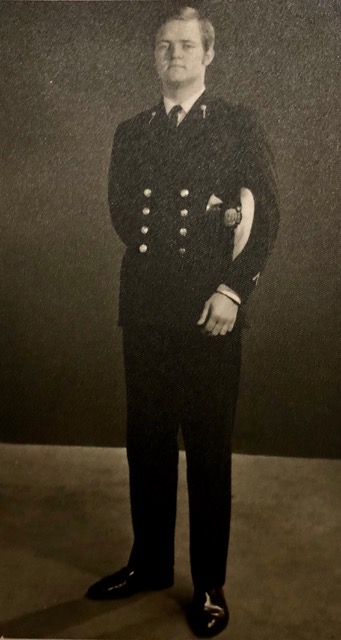 Steve attended the Merchant Navy College
Steve attended the Merchant Navy College
In September, 1968, I arrived at Greenhithe , Kent, to begin my studies at the newly-created Merchant Navy College (formerly HMS Worcester). Like the Mercury, the ship aboard which we lived was moored on a river, in this case the Thames, but we didn’t often venture ashore as the vessel was well-equipped with classrooms, galley and mess hall. And bunks – no hammocks! At the MNC I continued my study of navigation and chart work (I had obtained my GCE ‘O’ Level at Mercury) and was now introduced to additional subjects such as ship construction, meteorology and practical seamanship aboard the tender, formerly a trawler, MV Glen Strathallan, aboard which we sailed out of the Thames estuary into the North Sea. That certainly tested our sea legs!
In my second, and last, term at the MNC I befriended several senior Deck Officer Cadets who had already been to sea for up to a year and who had been returned ashore by their shipping companies to receive yet more formal instruction. A couple of those lads were employed by Esso Marine and I was so encouraged by their description of their lives aboard ship that I applied to Esso Marine for a position. The fact that oil tanker sailors were better paid than cargo ship crews was only a minor consideration!
Deck Officer Cadet Smedley
Towards the end of June, ’69, I had been accepted by Esso but had not been assigned to a ship so I travelled to my parents’ home in Rawalpindi, Pakistan, to await the news of my engagement. Two weeks later, I was directed to travel to Rotterdam to join the MV Esso Warwickshire, which was about to set sail for six months in the Mediterranean Sea. I was to quickly learn the joys of ‘tank-diving’ as we cleaned the crude oil cargo tanks between Rotterdam and our first port of call, Es-Zuwetina, in Libya.
MV Esso Warwickshire
Moreover, I quickly realised that I wasn’t going to see much of the places that we visited. Our turn-around time in any port, as we loaded or discharged our oil, was usually less than twenty-four hours. What’s more, the oil terminals were generally situated some way out of town, if we tied up at all. Some of our cargo was loaded from floating pipelines a mile offshore. No wonder we were paid a bit more than other merchant seaman; it was small compensation for almost never being able to get ashore. Not that I would have been able to anyway – as a first-tripper deck officer apprentice, I was very junior in the pecking order when it came to shore leave.
We plied back and forth between North Africa, Italy and France for a couple of months until a mishap in Sardinia. As we entered the port of Caligliari, under the direction of a harbour pilot, we ran aground. The Captain was incensed as he’d made the approach innumerable times and had questioned the pilot about the course we were on (I was on the bridge that day) but the pilot assured him that we would be fine navigating through this new channel. Oh dear. We were stuck fast until tugs could gently free us. The bulbous bow was inspected and determined to have been damaged. Not so much so that we were unseaworthy but enough so that we made directly for dry dock in Genoa for repairs and for a refit that would have been due a few months later anyway.
We were to have been in dry dock for two weeks but labour unrest in the dockyard extended that sojourn to six weeks during which time we, the crew, were paid a generous per diem to lodge in hotels and to eat ashore as the ship would be ‘dead’. The Engineers quickly devised a way to surreptitiously run power and water lines aboard from dockside, enabling us all to continue to live on the ship. Throughout the daytimes I learned all about the architecture and the operating systems of the vessel – but the evenings ashore were certainly an education for this seventeen-year-old sailor!
Repaired and refitted, the ship resumed service by the middle of October. In early December, we were fully-laden and homeward bound when I endured a life-changing experience. As we passed through the Bay of Biscay in a fearsome Force Eight gale, with massive seas, a section of grating on the catwalk that ran above the main deck was washed away. Unfortunately, although the word was passed about, I did not learn of this hazard and nobody had thought to rope off that portion of the walkway. It was probably assumed that everyone who worked on deck knew about it but I had had no occasion to go forward from the central accommodation area until, upon our approach to Fawley, near Southampton, a day or so later, I was on the bridge and directed by the First Mate to go for’ard and extinguish a work light in the fo’c’s’le that someone had left on and which, in the darkness, was impairing our vision from the wheelhouse.
As I proceeded ahead I suddenly realised that my horizon had disappeared and that I was falling! The gap in the catwalk had claimed a victim. I fell about twelve feet and landed heavily, striking my right leg on a piece of equipment. Shaken, but not stirred, I got up and continued my journey, hobbling all the way. I turned off the offending lamp and returned along the main deck to the bridge. As I entered from the wing, the First Mate looked at me and asked, “What happened to your leg?” I looked down and for the first time saw that my trouser leg was bloodied and torn and that my right shinbone was shining whitely through. That’s when I swooned. I was assisted to my cabin, where the Steward administered a dose of morphine and a hearty shot of rum (aah, naval medicine). Within hours, I was in a hospital in Southampton where it was determined that, although I had a nasty wound, I had only ‘chipped’ my tibia and, thankfully, not suffered a serious fracture. Nonetheless, I was deemed unfit to return to sea and was to spend time ashore to recuperate.
I made my way to the home of family friends in Woking, Surrey, where I spent my days reading, watching television and helping around the house wherever I could. Much of my time was spent in solitude, feeling sorry for myself. Fed up, f****d up and far from home (as the saying goes), I was gazing out of the living room window one day when I saw a Bobby strolling by on his beat. “Aye, aye,” I thought, “There’s a chap who’s got it made. A uniform, a steady paycheque, a place to live with three squares a day, apparently not much to do and all day in which to not do it. I think I’ll have me some of that!” And so, with the impulsivity of youth, I explored the possibility of joining the Surrey Constabulary.
I soon learned that I was too young, at seventeen, to join as a constable but that the force was hiring police cadets so I threw my hat into the ring. My hosts wanted their couch back so I left Woking and moved to my uncle and aunt’s place in Farnborough, Hampshire, after Christmas. My leg was healing fairly well and, as the police force had indicated that I wouldn’t be engaged by them before mid-April, I took a job as a Trainee Manager at Woolworth’s in Aldershot. I had sought temporary work at various places but no-one was willing to hire me for a short-term, unskilled, position because I was ‘over qualified’. So I resorted to a little white lie at Woolworth’s, telling them that I was looking for a career in retail management. Of course, the first thing that they did was send me to work in the warehouse so that I might understand how the back room operated!
Metropolitan Police Cadet Training Centre
Young Cadet Smedley in front row centre
On the 20th April, 1970, I was one of a group of ten Surrey Constabulary cadets who were the first to undergo training at the Metropolitan Police Cadet Training Centre at Colindale, north London. I spent seven months there, thoroughly enjoying the dormitory life, the square bashing and the spit and polish. The Drill Sergeant was an ex-Irish Guardsman who had been enticed into retirement from the army by the Met Police, who gave him police sergeant’s stripes and installed him as the disciplinarian at the Cadet Training Centre. The Commanding Officer was also ex-army, Colonel Andrew Croft (retired). The curriculum at the MPCTC included English, History, British Constitution, Typing and an extraordinary emphasis on physical activities. Boxing, judo, swimming, kayaking, athletics, football, rugby, hockey, Outward Bound exercises; all manner of challenges, including the summer centrepiece – Major Camp, five days spent in Epping Forest, practicing woods craft and map-and-compass skills.
I completed the course in December, 1970, and reported to my first posting in Surrey at Camberley Police Station. The building had been recently opened and was a handsome, modern edifice with a Section House and a social club. I was greeted with some suspicion by the other cadets, who had not had the benefit of the MPCTC training experience, but that quickly evaporated when it became clear that I harboured no sense of entitlement over them. I was eager to learn and was also quickly accepted by the police officers with whom I was to work for the next ten months.
I started with a period in the station’s Front Office, assisting the Station Constables with the members of the public at the counter, usually dealing with smaller matters such as Lost & Found property, and occasionally helping in the cell block. I also spent a fair bit of time on the switchboard, one of those contraptions with cords that connected outside lines with the internal numbers. It wasn’t rocket science but I still managed to occasionally, inadvertently, disconnect a caller. Happily, that old-fashioned system was replaced with a modern version that only entailed transferring callers by the pressing of buttons.
Very soon, I was accompanying constables on the beat, walking eight-hour foot patrols, learning streetcraft, discovering the various tea-stops and dealing with a variety of petty crimes, neighbourhood disputes, and complaints that really were not police matters at all but which the Bobby was nonetheless expected to resolve. Two early lessons that I learned: (1) “A copper never runs to anything. You’re no good to anyone if you arrive all flustered and out of breath”, and (2) “A good copper never gets caught in the rain”. So, we occasionally spent part of any wet evening shift standing in the rear of a darkened cinema. Management was always happy to have policemen on the premises to keep the yobs in line.
I was very happy, too, to be seconded for a couple of weeks at a time to various specialist units: The Area Car, the Traffic Division, the CID, the Scenes of Crime Officer, the Collator, even a dog handler for a day or two. All these brief attachments offered me some insight into the roles of those players. What they could do for me and what I could do to assist them. Of course, I spent a fair bit of time making tea and filing but it nonetheless familiarised me with the people there and the nature of their duties.
I was exposed to the harsh reality of death, attending several fatal road accidents and a few sudden deaths, including suicides. As a cadet I didn’t have to handle the files, nor complete the paperwork, but I learned what the priorities were, who to call upon, how to deal sensitively with next-of-kin, all by silent observation. I was an extra pair of hands, eyes and ears for the investigators. Most of the time, I kept my mouth shut. Hard to believe, I know, but I managed it.
In October, 1971, I was Attested as a Police Constable and travelled from Camberley to Sandgate, near Folkstone, Kent, for my initial training course at the Number 6 District Police Training Centre, where I joined other PCs from Surrey, Kent, Hampshire and the Channel Islands. There were no policewomen there as training was segregated in those days. Surrey sent its WPCs to the training centre at Ryton-Upon-Dunsmore, near Coventry in Warwickshire.
Attending No. 6 District Police Training Centre, Sandgate, Kent
October 1971 - January 1972
Young P.C. Smedley is 3rd from left on the 3rd row
Upon completion of my basic training, in January, 1972, I was posted to Addlestone Police Station to continue my career as a constable. After a short period of guidance under the watchful eye of my Parent Constable, I was unleashed alone upon an unsuspecting world. I was now endowed with the powers and responsibilities of a peace officer and I thoroughly enjoyed my time at Addlestone. My foot beat area included the town of Chertsey and my occasional bicycle beat area covered an even wider portion of the district. I lived in the Section House and was soon the Assistant Social Secretary at the Police Club.
P.C. 925 Steve Smedley
Surrey Constabulary 1973
At Addlestone, I passed my driving test and quickly applied for a police driving authorisation test, which, amazingly, I passed at the first attempt. Now I was deemed to be an Authorised Driver and was occasionally permitted the privilege of patrolling in a Morris 1000 panda car, usually when someone else was away on leave. This of course expanded the variety of calls that I was called upon to deal with. Although leafy, suburban, Surrey might appear on the surface to be a sleepy, low-crime, county it nonetheless endured its share of human misery and I witnessed a good deal of it.
Of course there were lighter moments. On one occasion, when I happened to be accompanied by the patrol sergeant, I was dispatched to Byfleet & New Haw railway station where a man had attempted suicide by jumping in front of an oncoming train. Anticipating a bloody mess upon our arrival, we were astonished to find that the misguided soul had been at the wrong end of the platform and that he had thrown himself onto the tracks as a train approached – and made its intended stop before it reached him. Our job was to rescue him from the irate train driver who had set upon him in outrage!
On the afternoon of Sunday, the 18th June, 1972, I was in the Section House at Addlestone when, shortly after 3:00pm, I and all the other residents were sent immediately to the scene of the crash of a British European Airways Trident jet near Staines. The aircraft had come down in an open field near a residential area just minutes after takeoff from Heathrow Airport, killing all 118 people on board. The scene was one of organised chaos, emergency services being hampered by the huge crowds that had quickly gathered to rubberneck. I was assigned to inner perimeter duty, adjacent to the smouldering wreck, where I spent several hours in the jet-fuel sodden grass. Although I was in those days a smoker, there was no likelihood of a fag at that scene. I stayed on site well beyond darkness, eventually being relieved but back again only a few hours later. The removal of all the victims was a grim process.
A couple of months later, I was transferred from Addlestone to Egham, a smaller town across the river from Staines. The area was quite affluent and contained Runnymede, where the Magna Carta was signed, Sunningdale, which boasted a world-class golf course, and Virginia Water, where many show business celebrities made their homes. And many a burglar made his living!
Early in 1973, I was again transferred – being single, I was considered to be ‘mobile’ – this time to Reigate, on the A23 halfway between London and Brighton. I enjoyed foot patrol in Reigate and Redhill, and cycle patrols wider afield. In my panda car I was always on the lookout for criminals travelling between The Smoke and the Coast and I, along with my colleagues, managed to intercept a few villains.
Gatwick Airport was, at that time, in our area of jurisdiction and I was several times detailed to join a small squad of officers who stood by in the terminal as the passengers for El Al flights to Israel were thoroughly screened and searched. We were six coppers, one of whom was an authorised firearms officer. By the arcane rules of that era, the Webley revolver was carried, unloaded, under his tunic. If an attack occurred he was to draw his weapon, load it and act accordingly. We others joked that we’d all take station near a column where we could seek shelter while any Bad Guys returned fire! Happily, there was never a crisis.
In mid-1974, having passed the five-week-long Standard Car Course, I was seconded to the Q-Car, a nondescript, unmarked police vehicle crewed by two PCs in plainclothes and a Detective Constable. Our remit was to assist the various sub-divisions and CID with surveillance/observation or enquiries as required.
On the 6th July, ’74, PC John Schofield and two other Surrey policemen were attacked by a gunman in Caterham. John was fatally shot, and colleagues Ray Fullalove (a personal friend of mine) and Jim Findlay were wounded. The gunman had fled on foot and was still at large when we, the Q-Car, were attached to the Murder Squad the next day. The offender was arrested in London on the day of John’s funeral; my colleagues and I were to assist in the searches around the Surrey countryside and on the South Coast for the murder weapon in the period that followed.
On the evening of Friday, 5th October, 1974, at around 8:30pm, my partner and I were patrolling near Dorking, Surrey, when our police radio burst into life with reports of an explosion in a pub in downtown Guildford. All units in the vicinity were directed to attend. Although we were not, strictly speaking, ‘in the vicinity’, we activated our siren and made our way at top speed to the scene. We arrived just as a second explosion occurred. It later transpired that two pubs, The Horse & Groom and The Seven Stars, had been targeted by the IRA, killing five people and wounding sixty-five others.
Uniformed personnel dealt with the scene. We were directed to join other plainclothes officers in intercepting and identifying any pedestrians that we encountered on the streets of Guildford, and in noting the make, model, colour and licence number of all the vehicles parked in the city at that time and through the night. Over the next few days we were kept busy responding to a plague of hoax bomb calls. Eventually, as the calls subsided, we were given Actions to follow-up on. By early December, my stint on the Q-Car was over and I returned to uniform duties at Reigate.
 Syke Smith recruited many hundred young constables
Syke Smith recruited many hundred young constables
During the autumn, I had decided that I would like to try a tour of policing overseas, in Bermuda, with the intention of returning to Surrey in due course. I was interviewed in London by then-Chief Inspector Syke Smith and another senior officer whose name now escapes me and, in due course, I was delighted to receive a letter informing me that I had been accepted.
Bermuda Police Induction Course - 1975
Top (l-r) PC's Alan Smith, Space - due to injury to Alan Cleave !
Steve Smedley, Paul Cranage, Dave Cart & Peter Giles
Middle row: Mike Ross, Dave Allen, Peter Gimson,
Angus MacDonald & Gerry Benson
Seated: Ian Kittle, Graham Alderson. Sgt Barry Meade, C/Insp Dave Parsons
Sgt Ian Scotland, PC's Alistair Delanzo and John Wright.
On the 4th February, 1975, I arrived with several other constables, recruited from various forces, to join a handful who had arrived the day before. There were fifteen of us altogether, greeted by Chief Inspector Dave Parsons, Sgt Barry Meade and Sgt Ian Scotland of the Training School. Ian looked long and hard at me and asked, “Smedley, are you related to a Regimental Sergeant Major John Smedley, Royal Military Police?”, to which I replied, “Yes, Sergeant. He’s my father.” Ian paused, then with a mischievous glint in his eye and a manic grin said, “Aah. Now it’s my turn!” Yes, he’d served with my dad and did not have particularly fond memories of that period. Of course, Sgt. Scotland was only joking and he and I got along very well throughout my service in Bermuda.
Our local orientation course passed reasonably uneventfully, although Alan Cleave was missing from the Course Photo as he had suffered a crash of his moped and was recuperating in hospital. It was during our course that we learned that we had arrived just in time to bolster the ranks of the Bermuda Police Force when the Queen was to visit between the 16th and 18th February. So, I was deployed to several places over the three days, mostly to police the onlookers and control traffic. I’m almost certain that, when Her Majesty passed me for the umpteenth time by the third day, I heard her say to Prince Philip, “That PC Smedley certainly gets around, doesn’t he?”
My initial posting was to Western Division, with Dave ‘Rookie’ Adams and Alan Smith. We took up residence at the barracks at Watford Island and quickly settled into our new surroundings under the command of Inspector Hilton ‘Jellybean’ Wingood. I was assigned to a section supervised by Sergeant Neville Phillips, who handed me to PC Lawrence ‘Mincy’ Rawlins for a week or two of orientation. What a happy introduction to policing in Bermuda. Mincy knew everyone in Sandys Parish and most of the population of Southampton Parish too, it seemed, and I was introduced to all of them!
No account of my time in Bermuda would be complete without special mention of Michael Phillips, whose friendship has endured all these years. It was he who introduced me to the Canadian Forces Station at Daniel’s Head, where he was well known and the place where I would eventually meet Peggy, who was to become my wife. On our three visits to the Island since 2007 Peggy and I have been sure to visit with Mike and Ann.
Others whom I recall fondly are Sgts John ‘Coco’ Eve, Dave Barber, Mike Rickards (whose aunt I had met, on my beat, in Redhill and who had spoken proudly of her nephew), PCs Howard Cutts, Brian Malpas, Andy Donaldson, Dick Naylor, Foster Burke, Alan and Gertie Barker, Howard Cutts, Dai James, Louis Griffiths, George Jackson and so many others whose faces are in my mind’s eye but whose names are now difficult to retrieve.
The social aspect of life in Bermuda at that time, and undoubtedly to this day, was a key ingredient in bringing together the police and the community and, equally importantly, the members of the police force itself. The Police Recreation Club was in many ways the heartbeat of the force and many events and activities were organised by the PRC. I was a keen footballer and enjoyed playing for Western Division and, occasionally, Prospect FC, which widened my circle of friends and acquaintances.
Prospect Football Club - 1976
You can view this photo, with the names of everyone in it, in our Who, When and Where
Speaking of Western Division football, perhaps my most indelible memory is that of our goalkeeper, Howard “The Cat’ Cutts. Howard’s approach to the game was unique; when the ball was in the opponents’ half, Howard could be seen leaning against his goalpost, sipping on a ‘cold one’ with one hand and enjoying a cigarette in his other hand. As the ball approached his area, he would place both items in the back of his net, perform another casual act of breathtaking agility, send the ball downfield and resume his relaxed pose in the goalmouth. Simply amazing.
In mid-1976 I was transferred from Western to the Marine Section, under Sgt Gerry Ardis. My arrival meant that the small unit of seven had three Steves: Steve Rollin, Steve Petty and myself. The others were Alex Arnfield, Perry Fox and Phil Every. Steve Petty had the dubious distinction of breaking me in; I hadn’t been in a boat since 1969 and my skills were, to say the least, rusty! Thankfully, Steve had eternal patience and a good sense of humour, both of which he certainly needed. Together, we crewed White Heron and he generously shared his experience and knowledge while I reclaimed my small craft handling abilities. I studied for, and achieved, my Class C Pilot’s Licence and steadily improved in confidence. One of the early highlights of my Marine Section service was navigating through the fleet of Tall Ships that had congregated in Bermuda before heading en masseto the United States for the bicentennial celebrations.
When I moved from Western I had taken over an apartment on Point Finger Road which, I think, had been occupied by Ray Needham. I recall that I won a turkey in a raffle at the PRC just before Christmas, ’76, so I invited my pal Ian Kittle and several other lads to join me for a roast turkey meal on Boxing Day. Perry Fox had very kindly invited me to join him and his family at their home in St David’s for Christmas Day and I figured that I’d be back that evening. Alas, I over-indulged and spent the night in St David’s. When I arrived at my place at midday on Boxing Day I found that my chums had arrived and, finding me absent, they had ‘effected entry’, put the turkey in the oven and were helping themselves to some Christmas cheer from my bar! I quickly checked the oven and discovered that the turkey was upside down and the bag of gizzards was still inside. It had only been in for a few minutes so there was no harm done and we eventually enjoyed a decent nosh-up. I recall that Ian was working evening shift at St George’s so he left in time to get to work.
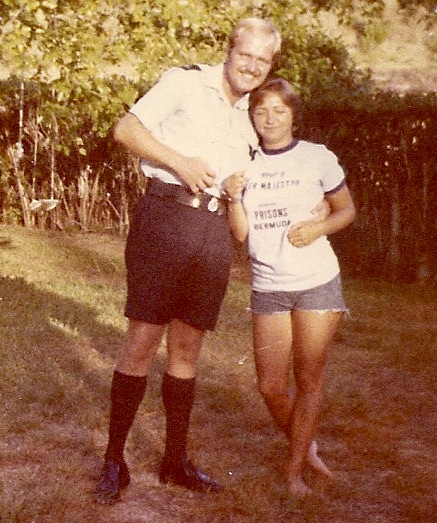
Steve and Peggy
Handcuffed Together Forever! 1976
Well, all good things must come to an end. Peggy and I had decided that we would get married and we set the date for the 27thAugust, 1977. Sgt Ardis had pencilled me in for a diving course but that was now out of the question. Moreover, the force was considering the purchase of a new, larger and more modern vessel to replace the Blue Heron, which had sunk following a collision with a harbour ferry. The new boat would have to be sailed down from New York and Gerry, Phil and I were all being considered at one point as crew (my claim to fame being my navigation training). I knew that I was pretty far down the pecking order and unlikely to be selected so I wasn’t too disappointed that I was leaving before the acquisition of the boat and the grand adventure. Hey, I was getting married – an even more exciting proposition!
Ian Kittle attended the wedding in Ottawa as my Best Man, and Mike Phillips was an Usher. Within a few years I would be attending both of their weddings in Canada, too.
Steve (centre) with Ian Kittle and Mike Phillips on his wedding day - 1977
Officer 38 Steve Smedley
Gloucester Police Force 1978
I worked briefly at the Ottawa-Carleton Detention Centre as a correctional officer while I awaited an opening in the ranks of the Gloucester Police Force, in a suburb of Ottawa. I served with Gloucester from the 1st December, 1977 until, having obtained my Canadian citizenship, I joined the Royal Canadian Mounted Police on the 8th June, 1982. I was to serve with the RCMP exactly twenty-nine years until my retirement on the 8th June, 2011, a policing career of forty-one years.
My service with the RCMP began with six months of basic recruit training at ‘Depot’ Division in Regina, Saskatchewan. Despite my twelve years as a police officer, it was decided that I should undergo full training as I had not received any formal instruction in Canada (the Chief of Police in Gloucester had accepted my British training as sufficient for his needs).
My first posting, on 6th January, 1983, was to Wainwright, Alberta, where I performed general detachment duties in that small town in east-central Alberta. Wainwright and district, an area of about 4,000 square kilometres and with a population of around 10,000 in 1983, included a Canadian Forces garrison and a large military training area. In the 1980s the population swelled in the summertime by 20,000 as troops arrived for manoeuvres. It certainly made for a lively time, even as only a company of soldiers (about a hundred and twenty) was permitted into town at a time for recreation. Our detachment consisted of a sergeant, a corporal and eight constables so we were augmented by Mounties from other nearby detachments, on secondment for a couple of weeks each.
Peggy was a Registered Practical Nurse and she secured a position at the local hospital. It was in Wainwright that our two daughters were born: Vivian in 1983 and Stephanie in 1985.
In July, 1989, I was posted to Edmonton International Airport Detachment, performing aviation security and general policing duties, and enforcement of the Aeronautics Act. Although it was certainly a change of pace for me, Edmonton’s airport was not especially busy in that era and the detachment strength of over fifty members meant that we spent an inordinate amount of time rotating through static duties, terminal foot patrol and airside perimeter patrols. Within a couple of months, I was becoming bored - although very fit, as we had plenty of time to spend in the gymnasium. Fate stepped in to help me out.
For the first time, the Government of Canada had acceded to a request from the United Nations to provide a contingent of one hundred police officers to bolster the UN Civilian Police (UNCIVPOL), this time for the UN Transition Assistance Group in Namibia (UNTAG). The RCMP, as Canada’s federal (national) police force, was handed the task. On the 17th October, 1989, I was part of that body of ninety-six men and four women to travel to southern Africa, the RCMP’s first foray into UN peacekeeping operations. Upon arrival, ten of us were sent from Windhoek, the capital, to the far north-eastern town of Katima Mulilo in the Caprivi Strip to join peacekeepers from the Netherlands, India, Jamaica, Finland and elsewhere. Our mandate was to monitor the newly-formed South-West Africa Police (SWAPOL) to observe their policing practices and to deter and report human rights abuses, to provide with SWAPOL security for the polling stations during the upcoming elections and to ensure that there existed conditions for a free and fair election. Happily, all went well and Namibia achieved its independence without major incident. By the end of March, 1990, we were all back home.
I resumed my duties at Edmonton airport but again was looking for career development opportunities; once again, luck was on my side. I had identified a desire to undergo French language training and was fortunate to be selected to attend a full-immersion course in Edmonton in October, 1991. I graduated from the course, fully functionally bilingual, in June, 1992 and was posted to the northern Alberta city of Fort McMurray to perform general detachment duties. Fort Mac, as it is affectionately known, was then a community of about 45,000 people, most of whom were employed by the oil sands mines and production plants and associated services. Our detachment of sixty-five members was kept very busy, especially in the bars downtown every night. As the work force was mostly shift workers, it was a city that never slept!
In the fall of 1994, I transferred to Highway Patrol duties. We were a two-man unit, concentrating on a 250 kilometre stretch of wilderness that was Highway 63 towards Edmonton. I enjoyed the solitude despite the ever-present knowledge that, as I was alone, reinforcements were a long way away if needed.
In December, 1995, I was again selected for a UN peacekeeping mission, this time to the bilingual UN Mission in Haiti (UNMIH). Following the ousting of a military junta, law and order had broken down in that Caribbean nation and UNMIH was in place to assist the country with its transition to peace and stability. I arrived in February and was assigned to the Port-au-Prince Rural Detachment, policing the suburbs and district surrounding the capital city. Despite several tense situations, the elections were held and a government democratically installed. I returned to Fort McMurray Highway Patrol in October, 1995.
In April, 1996, I was transferred, upon promotion to corporal, to ‘Depot’ Division as a driving instructor. Eventually, I would also occupy positions as a drill instructor, a media relations officer and, with promotion to sergeant in 2002, the manager of communications and events management services. In 2004, I was to assigned full-time to duties as the project manager for the design, development and construction of the RCMP Heritage Centre, a new regimental museum (https://rcmphc.com). The building opened on time, and on budget, on 23rd May, 2007.
In July, 2007, Princess Anne, the Princess Royal, came to dedicate an area ‘The Princess Royal Walk’. When I was presented to her, she immediately picked up on my British accent and remarked, “You’re a bit off your patch, aren’t you?” I told her that I had been in Oxted, Surrey, in 1973 or ‘74, when she visited a stable that had a riding for the disabled programme. Her Scotland Yard bodyguard had been quite discomfited when she went off-script and rode away from us, with four Bobbies trying to keep up for about thirty yards! We reminisced briefly but her attending ‘thingies’ cut her off and dragged her away to keep her on schedule. It was a delightful encounter.
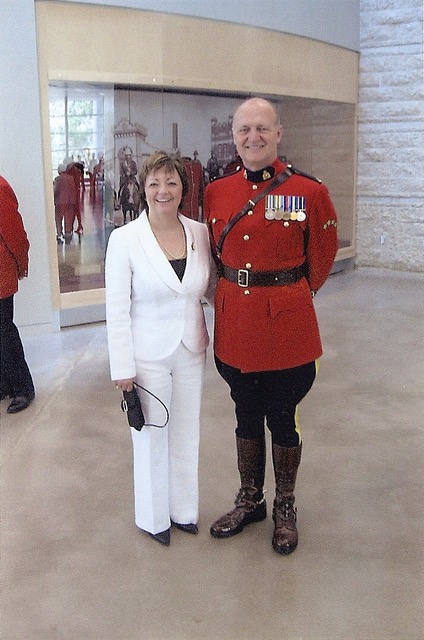 Steve and Peggy Smedley were presented to The Princess Royal
Steve and Peggy Smedley were presented to The Princess Royal
when she visited Regina to open "The Princess Royal Walk" in 2007
In 2005, as I was already engaged in the Heritage Centre project, I was assigned to a new team that was dedicated to the targeted spending of $150 million on infrastructure improvements and renewal at ‘Depot’. I was the Projects Coordinator, assisting in the identification of needs (versus ‘wants’) and of ensuring that the many construction activities did not interfere with the ongoing training programmes. By the time that I retired in June, 2011 we had completed, or almost completed, the renovation or expansion of, among others, such facilities as the swimming pool, the drill hall, the former museum building, the firearms range and the Division mess hall, and had replaced some unsexy but important services such as some sewage lines and the entire electrical supply system to the base, including the construction of an emergency power generating building. We also installed temporary accommodation units to house the troops as we constructed three new dormitory buildings, the last of which was completed in 2015.

Sgt Steve Smedley, RCMP - Regina 2004
Steve's five medals are the Canadian Peacekeeping Service Medal,
the UN Peace Medal (UNTAG), the UN Peace Medal (UNMIH),
the QEII Golden Jubilee Medal and the RCMP Long Service Medal.
 Steve and Peggy attend our Summer 2011 ExPo BBQ
Steve and Peggy attend our Summer 2011 ExPo BBQ
With their long-time close friends Mike and Ann Phillips
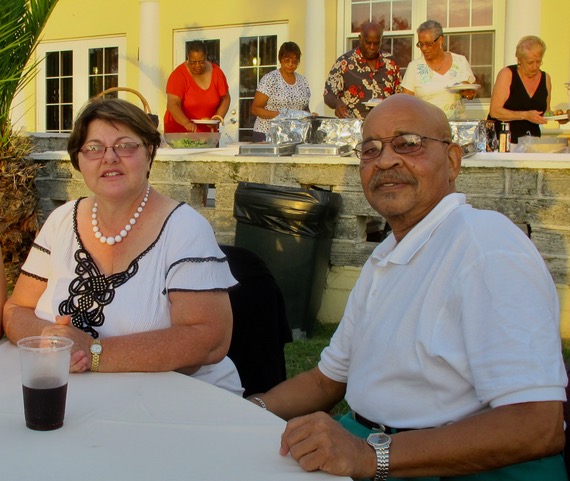
Mike and Ann Phillips at our Expo BBQ 2011
Since I retired, I have busied myself with a variety of volunteer activities and with my personal fitness. Peggy and I have travelled a bit, particularly to her native Nova Scotia and to Bermuda (2011 and 2015). Peg retired from nursing in September, 2018, and we are now happy to spend as much time as possible with our grandchildren. We have two young granddaughters in Edmonton (our Stephanie married an RCMP member) and, here in Regina, a one-year-old grandson – and another grandchild on its way!
I’ve kept myself busy with a variety of volunteer activities in the Regina area - at one point I was busier than during the last year of my policing career! I’ve scaled it back a bit these days but still help out in the community where I can. but Peggy and I have done a little bit of travelling. To Chicago for a week to celebrate her retirement and, last year, to her native Nova Scotia for a month. Bliss.
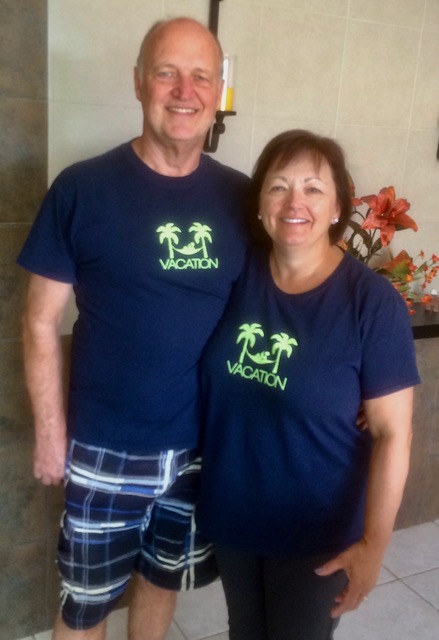 Steve and Peggy "On Vacation!"
Steve and Peggy "On Vacation!"
Due to the coronavirus pandemic we’re presently in our sixth week of social distancing in our apartment and Peggy hasn’t throttled me yet! Now that the sun has arrived we’ve been able to enjoy outdoor walks and cycling. There’s light at the end of the tunnel as Saskatchewan has been relaxing the isolation rules incrementally from 4th May.
Steve Smedley
25th May 2020
Editors note - We received the following email from Mike and Ann Phillips on 27th May 2020.
Steve, we appreciate you sharing your story, it is so well written. Thank you for including us in your article your friendship means so much to us. Steve and Peggy, hopefully once the world gets back to the new normal Bermuda once again will be your vacation of choice.
Until we meet again.
Michael and Ann
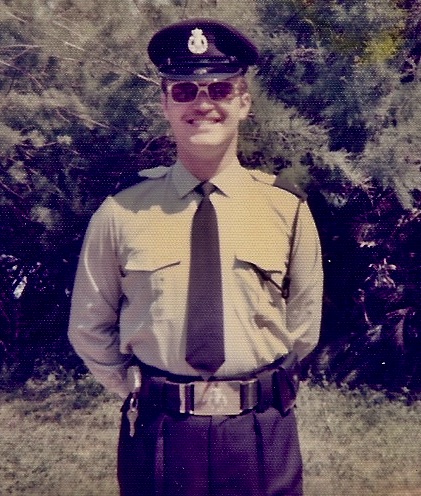
 Steve attended the Merchant Navy College
Steve attended the Merchant Navy College
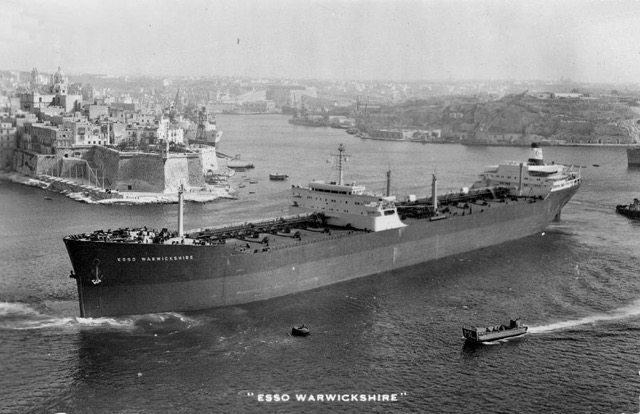
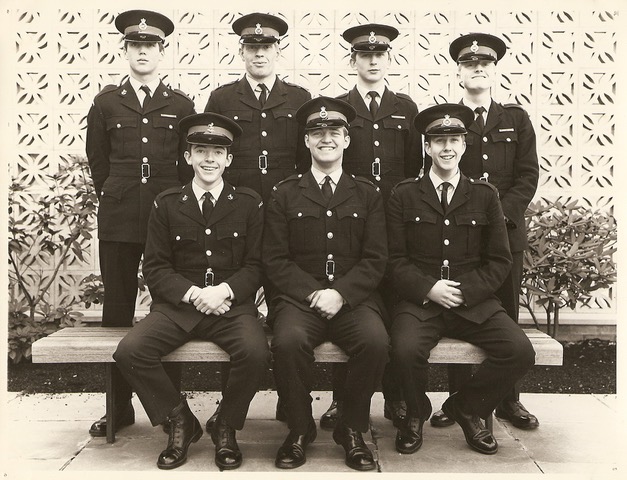
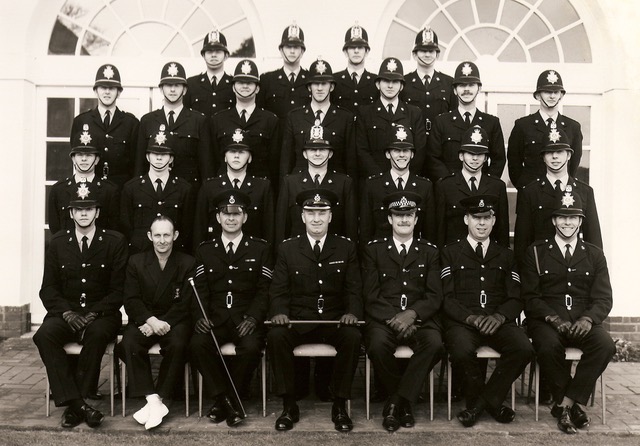

 Syke Smith recruited many hundred young constables
Syke Smith recruited many hundred young constables 



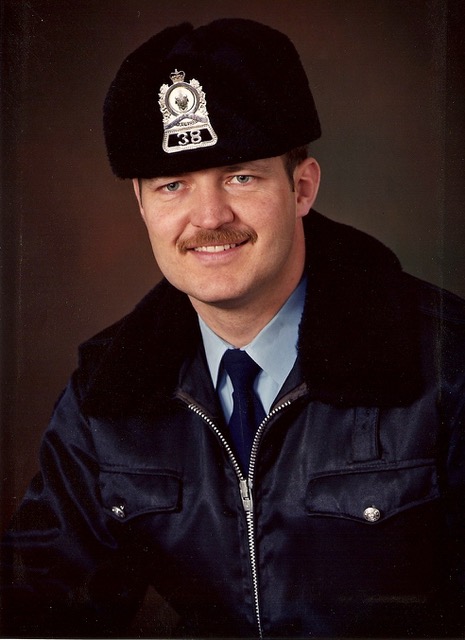
 Steve and Peggy Smedley were presented to The Princess Royal
Steve and Peggy Smedley were presented to The Princess Royal 
 Steve and Peggy attend our Summer 2011 ExPo BBQ
Steve and Peggy attend our Summer 2011 ExPo BBQ 
 Steve and Peggy "On Vacation!"
Steve and Peggy "On Vacation!"